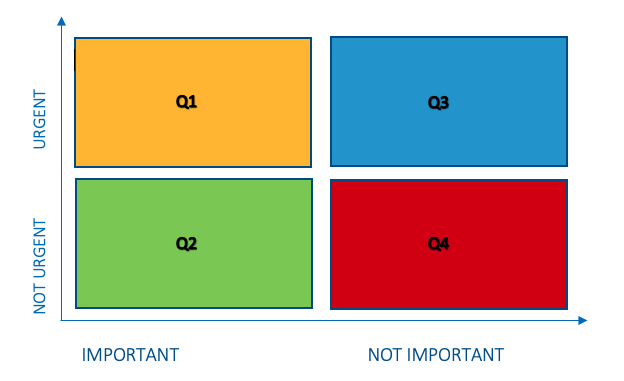Introduction
In this article, you will learn what the Eisenhower Matrix is and how you can use it to increase your productivity by managing your time better.
One of the biggest challenges is undoubtedly that of using time in the most functional and effective way. Working life absorbs a large part of our time, often invading the space of our personal life. The 24/7 internet connection often results in a bombardment of external impulses, with the power to distract us to the point of undermining our psychological and spiritual stability.
The risk is the triggering of a vicious circle that will end up lowering the quality of our life. The most common mistake we all make is believing that by dedicating more time to a task, we will be able to achieve more results. Unfortunately, nothing could be more wrong. To get more results we must learn to organize the tasks to be done according to the time they require.
The Eisenhower matrix (taken up later by Covey in the book 7 habits of highly effective people) is a perfect means to work in this direction.
Let’s see how it works together.
Time management and procrastination
How many times do we have the feeling of “not having time”? How many times do we find ourselves close to a deadline having done little or nothing? The causes can be the most varied, from the lack of organization to the tendency to procrastination. Unexpected events and distractions also play their part. The negative news can be seen in one of these four factors. The positive is that the Eisenhower matrix is based exactly on these four variables and uses them to optimize process and results.
We often tend to identify the concept of productivity with that of stress and continuous work. This definition resonates more with an outdated idea. The truth is that each of us can and must establish our own productivity paradigm. This is based on the type of activity or goal you want to achieve, be it the management of a company or the organization of the week. The type of business for which it is used has no influence on the way the Eisenhower matrix is used and operated.
How the Eisenhower matrix works
As mentioned, the Eisenhower matrix is based on four variables:
- Urgent
- Not Urgent
- Important
- Not Important
In literature and on the internet, this matrix is often depicted in quadrants. The y-axis shows the urgency, the x-axis the importance. The quadrants that arise from the intersection of these factors are, therefore:
Q1 – Important and urgent
The activities that fall into this quadrant are often unplanned, the result of problems and unforeseen events. These require deep and immediate attention. Activities of this type in most cases do not take too long to complete. The resolution in the shortest time possible defuses the feeling of urgency which, if we postpone the activity, would pollute the quality of the time and attention for the rest of the objectives. It is therefore good to try to examine and liquidate these tasks first during our day.
Q2 – Important and not urgent
These activities are certainly the most important we have. The importance lies in the fact that these activities, if well thought out and planned, are the ones that lead us to achieve our weekly, then monthly and then annual goals. I am preparing an article on 1-, 3- and 5-year planning. When it is ready a link will appear here.
Unlike the previous ones, these activities are (and should be) schedulable. This means reserving slots in the daily agenda to examine and process them. We tend to think that we should plan a moment of the day only for practical activities. Nothing could be more wrong: practical tasks are often the result of decisions and / or planning. Setting aside a part of the day to make these decisions and plan them in the best possible way will reduce the time needed for the practical task (all the variables have already been resolved), guaranteeing a higher quality of the final product. Nonetheless, dedicating time to decision and planning could also lead to evidence that the practical task is not actually necessary, or perhaps it can be delegated.
Q3 – Not important and urgent
Two types of activities fall into this quadrant, both of which usually require little time. The first concerns tasks that, after careful analysis and planning, turn out to be urgent but not important. This, therefore, makes them delegable.
The other type of activity instead comes from the outside, from distractions and interruptions. These can be calls, messages, e-mails. It is important to judge clearly
when a call represents a priority (and therefore falls within Q1) and when instead just a distraction. This choice is made difficult by several variables, on all the dopamine shots we receive when we complete a simple but not important activity. The challenge, also according to Brian Tracy, is to resist the temptation to work on these activities first during our day. “The little things multiply,” says Tracy, “and end up taking up a lot of time and consuming a lot of energy.”
Q4 – Not important and not urgent
As the name suggests, these activities have the lowest priority. This quadrant can include both distractions (internet, social media, etc.), as well as practical activities but which do not directly help to achieve the set goals. I do not believe in absolutism. I believe this type of activity is useful for balancing the workload of a day or a certain period. It goes without saying that to use it in this way, a good deal of intellectual honesty and self-discipline are required. It’s so easy to fall into the dopamine and procrastination trap again.
How to establish your priority list
Around 1895 Vilfredo Pareto (1848-1923), an Italian sociologist and economist, managed to isolate a constant: in Italy, 80% of the possessions were owned by 20% of the population. Similarly, 80% of the wealth was in the hands of 20% of the population.
This concept has been taken up in several moments by different disciplines, with the words 80/20. How does it help us in time management? Simple, by ensuring that 80% of the results we want comes from 20% of the time dedicated to them.
Brian Tracy proposes a very simple and effective way to apply the 80/20 rule in writing our goals: First, make a list of 10 goals you want to achieve at the end of the day. Then choose only one, in your opinion the most important, cross it off that list and write it on another sheet. From the nine remainings, choose another goal that you think is important. Delete it from that list and write it on the sheet where you wrote down the other. In total, you have 2 goals out of 10, or 20%. Those are the objectives that must surely be in quadrants 1 or 2. The choice will be dictated by urgency. The other eight can be divided into the quadrants you think are most appropriate. You will work on these only after solving the first two.
How to apply the Eisenhower matrix in your daily life
To get to have a list of 10 goals to achieve, we need to be clear about our medium and long-term goals. This requires a good deal of self-awareness as well as inquiry. Personally, I benefited greatly from the help of journaling (read this article to find out what I’m talking about). That way, once my medium and long-term goals were set, I was able to track my progress and failures. I was able to highlight positive habits and trends and especially negative ones. The next step was therefore to be able to formulate realistic and crucial goals, useful for actually reaching them.
 So, my first piece of advice is: get into the habit of recording everything you do as part of the projects you choose to complete.
So, my first piece of advice is: get into the habit of recording everything you do as part of the projects you choose to complete.
The next step, once the long-term goals have been set, will be to draw up monthly goals. From there we will derive the weekly goals and consequently the daily ones. Here it will be easier to choose goals that are useful and realistically achievable.
Once this is done, you can apply Tracy’s suggestion, choosing the most important goal first, then the second most important.
At this point, it will be only a logical continuation to divide the remaining objectives of the list into the quadrants of the Eisenhower matrix.
Conclusion
It is the management of commitments that define how long it will take us to complete them. The idea that spending more time means achieving more goals is a false myth that we must remove from our mentality. Our productivity, the sense of satisfaction, and above all the health of our business, company, or project will certainly gain.
Try applying these tips in your daily life and let me know in the comments how you found yourself. Does it work? Did you have to revolutionize your way of doing things?
Did you like this article? You will also like this:
THE BEGINNER’S GUIDE TO JOURNALING
Discover more from Moreno Maugliani
Subscribe to get the latest posts sent to your email.

